| Hydrogen Alpha Solar Observing Program Coordinator:
Mark Simonson
1519 Ridge Drive,
Camano Island, WA 98282
(360) 387-9548
|
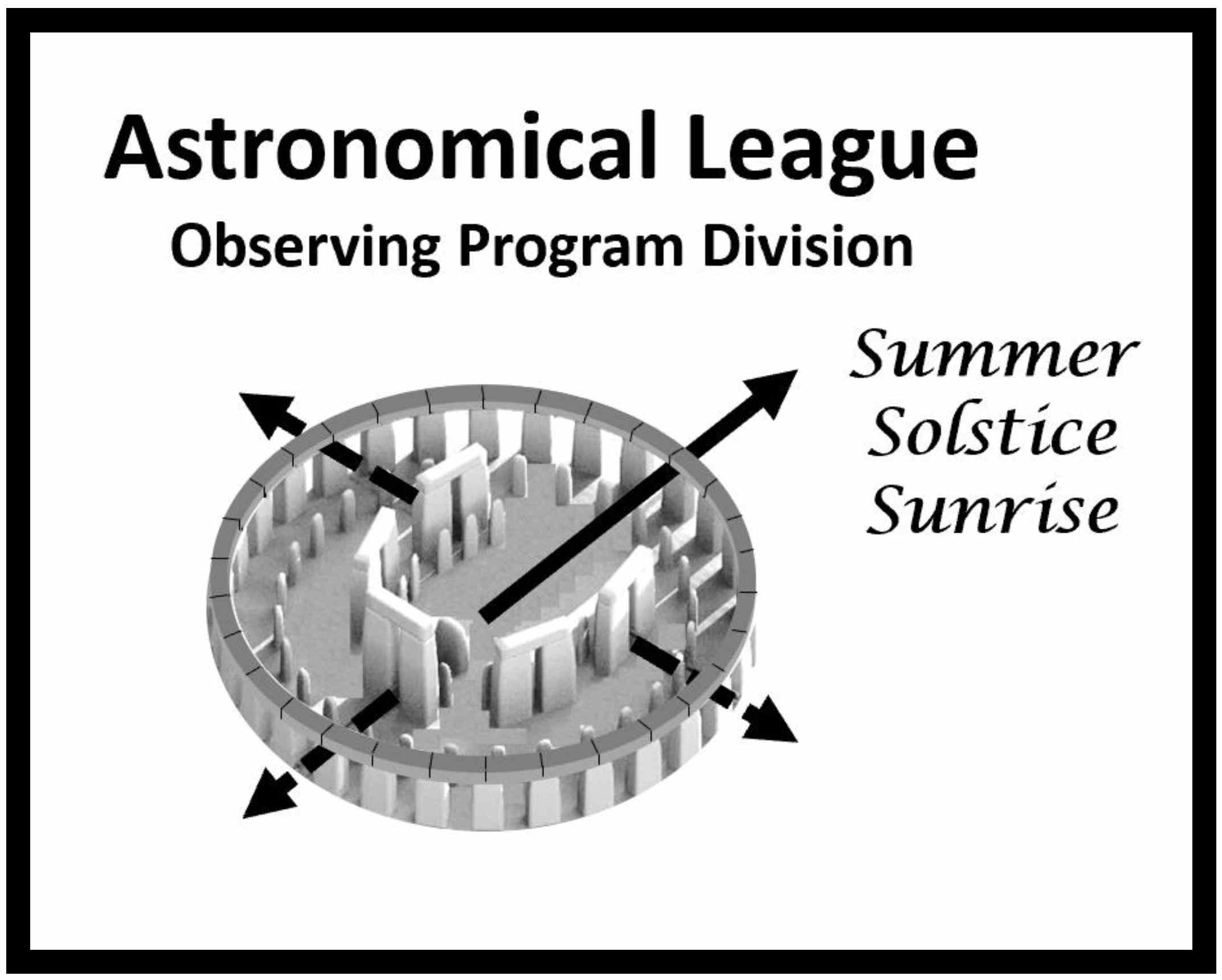 |
IntroductionThe Sun is one of the most exciting objects in the sky to observe. Solar observing in Hydrogen Alpha light is the only branch of amateur astronomy where you can see changes by the minute, rather than hours or days, unlike most astronomical objects. All events happening on the Sun are unique and never will be repeated. Whether you follow the growth and decay of a sunspot group, the rapid emergence of a solar flare, or the spray of an erupting prominence on the Sun’s limb, one thing is certain: the Sun will always present a uniquely different face, each and every day. Welcome to the world of Hydrogen Alpha Solar Observing! *** WARNING *** Before you start any solar observing program, make absolutely certain that you have safe filters and a safe set-up. Only use filters from reputable sources, and never use a “solar filter” that screws into an eyepiece. As Richard Hill states in Observe and Understand the Sun: “Observing the sun is the only inherently dangerous observing an amateur astronomer can do. Be aware of this at all times and take all necessary precautions. If you do not know a filter or procedure is safe then do not use it! Always err on the side of safety. An eye once damaged is forever damaged. Filters that let too much INFRARED light through can burn an eye if used visually. There is NO PAIN when this happens. Burned retinas can not be repaired. Excessive ULTRAVIOLET light has been shown to cause cataracts. So be very careful.” For more information on ways to safely observe the sun, click here. |
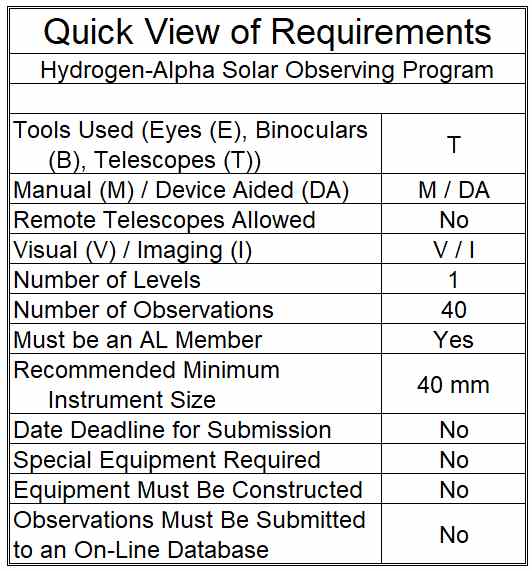 |
Requirements and Rules
This certification is available to members of the Astronomical League, either through their local astronomical society or as members at large. If you are not a member and would like to become one, check with your local astronomical society, search for a local society on the Astronomical League Website, or join as a Member-at-Large .
The Observing Program can be completed visually or by imaging. To complete the Observing Program, an observer will be required to make three sets of drawings or images. Observations should include:
The first set is 20 or more sketches or images of the whole solar disk during two solar rotations (one rotation is about 30 days). Only the main features need to be drawn: filaments, plages, flares, and sunspot umbra. The penumbra may be omitted since it has a lower contrast in H-alpha than in white light. The second set is detailed sketches or images of the different forms that solar prominences take on the limb of the Sun. These MUST include: |
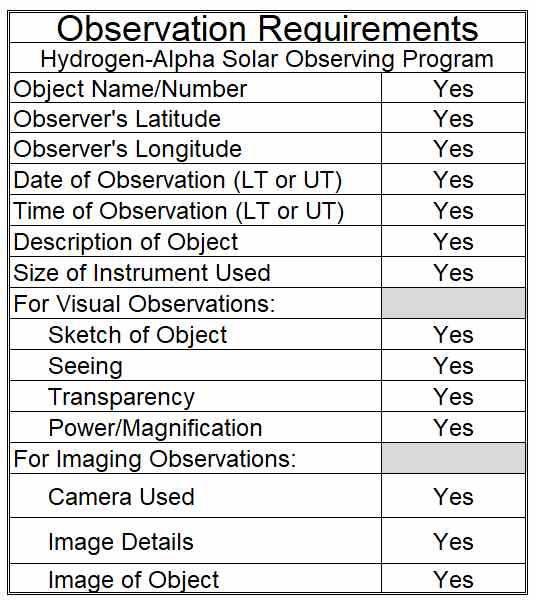 |

Single Arch—This is one of the most common shapes of a prominence, representing charged solar material flowing up from the solar atmosphere and down again following local magnetic field lines.

Double Arch—Much rarer than a single arch, this has two arches that are connected to each other via a center stream of material.

Broken Arch—Likely to be an evolutionary stage of a single arch, a broken arch features gaps in the stream of material where the plasma density is either too low to be detected or the material has been blown away or disrupted by solar wind streams.

Unconnected Arch—This is where one end of the arch has not reconnected to the solar surface. This is also likely to be an evolutionary stage of the single arch, where the material is still traveling down the magnetic field lines to the surface.

Straight Pillar—This appears as an eruption vertically up from the solar surface and is quite common. It could also be an arch seen edge-on.

Curved Pillar—This is simply a pillar that is bent out of shape by magnetic or other forces, and could also be the early stages of an arch seen at an angle.

Inclined Pillar—This is where the material at the base of the eruption and throughout the prominence is at a significant angle to the surface.

Mound—This is also a fairly common type of prominence, and is seen as a relatively but fairly low eruption. It has a width equal to or greater than its height.

Hedgerow—This is a grouping of many smaller prominences that are likely to have come from the same source of activity.

Pyramid—This common type is like a combination of a pillar and a mound, typically featuring a wide base that converges to a fairly sharp point.

Broken Pyramid—This is a pyramid that has some damage in the form of holes in the plasma stream, or whole sections of plasma that have broken off. It is also likely to be an evolutionary stage of a regular pyramid.

Fork—This is two prominences, typically of pyramid or pillar form, that are very close together. The width between them is usually less than the base width of the thinnest prominence.
 Detached—Here the material has lifted off the surface entirely and appears to be completely disconnected from the surface. It is possible that some low-density interconnecting material is there, but it is not detectable with the observer’s equipment.
Detached—Here the material has lifted off the surface entirely and appears to be completely disconnected from the surface. It is possible that some low-density interconnecting material is there, but it is not detectable with the observer’s equipment.
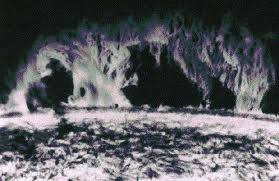 Anomalous—As is to be expected with any classification system, there are prominences that have no discernable shape or features that can place them in a distinct category. Due to the random and very complicated nature of solar surface eruptions and magnetic fields, these kinds of prominences are relatively common.
Anomalous—As is to be expected with any classification system, there are prominences that have no discernable shape or features that can place them in a distinct category. Due to the random and very complicated nature of solar surface eruptions and magnetic fields, these kinds of prominences are relatively common.
In the third set, you will make detailed sketches or images of individual features on the disk of the Chromospheric Sun, which MUST include six of the following nine features:
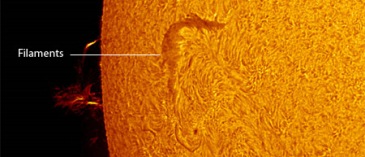 Filaments—Prominences seen against the face of the sun, appearing as long, narrow dark streamers or diffuse complex dark areas. Filaments often mark areas of magnetic shearing.
Filaments—Prominences seen against the face of the sun, appearing as long, narrow dark streamers or diffuse complex dark areas. Filaments often mark areas of magnetic shearing.
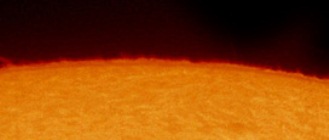
Spicules—Small jets of gas under 10,000 km high, usually seen as a mass of tiny brighter spike-like features on the limb or as tiny darker spikes coming out of network elements.
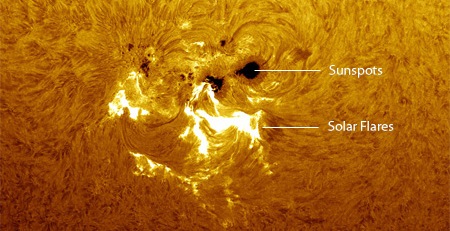
Flares—Intense, abrupt releases of energy that occur in areas where the local magnetic field is rapidly realigning or changing because of magnetic field stress.
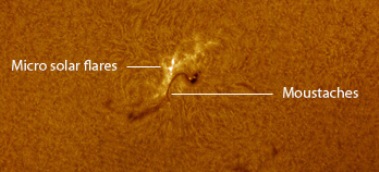 Ellerman Bombs—Micro solar flares that appear as tiny fairly bright transient points of light (usually less than 5 arc minutes), most often found in Emerging Flux Regions or on edges of sunspots where the magnetic field is breaking the surface. Also known as a Severny mustache.
Ellerman Bombs—Micro solar flares that appear as tiny fairly bright transient points of light (usually less than 5 arc minutes), most often found in Emerging Flux Regions or on edges of sunspots where the magnetic field is breaking the surface. Also known as a Severny mustache.
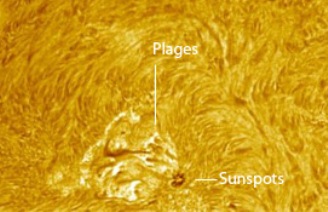 Plage—Patchy H-alpha brightenings on the solar disk, usually found in or near active regions, which can last for several days. Plage is irregular in shape and variable in brightness, marking areas of nearly vertical emerging or reconnecting magnetic field lines.
Plage—Patchy H-alpha brightenings on the solar disk, usually found in or near active regions, which can last for several days. Plage is irregular in shape and variable in brightness, marking areas of nearly vertical emerging or reconnecting magnetic field lines.
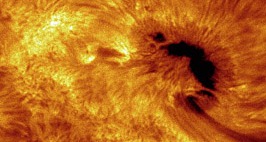 Field Transition Arches—Filament-like fibrils that cross the polarity inversion line of a bipolar magnetic region. A polarity inversion line is a line marking the halfway point between two opposite polarity areas.
Field Transition Arches—Filament-like fibrils that cross the polarity inversion line of a bipolar magnetic region. A polarity inversion line is a line marking the halfway point between two opposite polarity areas.
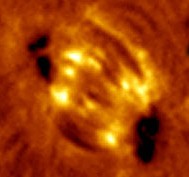 Emerging Flux Region—An area on the Sun where a magnetic dipole, or flux tube is surfacing on the disk, eventually producing a bipolar sunspot group. Each pole of an EFR is often marked by pores or small developing sunspots. Growth is rapid, forming in just a few hours.
Emerging Flux Region—An area on the Sun where a magnetic dipole, or flux tube is surfacing on the disk, eventually producing a bipolar sunspot group. Each pole of an EFR is often marked by pores or small developing sunspots. Growth is rapid, forming in just a few hours.
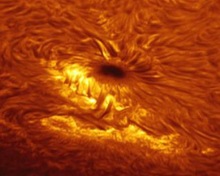 Sunspots—Temporary phenomena that appear visibly as dark spots compared to surrounding regions. They are caused by intense magnetic activity, which inhibits convection, forming areas of reduced surface temperature. Although normally a white light phenomenon, they do appear in H-alpha, but their penumbrae are lower in contrast than in white light.
Sunspots—Temporary phenomena that appear visibly as dark spots compared to surrounding regions. They are caused by intense magnetic activity, which inhibits convection, forming areas of reduced surface temperature. Although normally a white light phenomenon, they do appear in H-alpha, but their penumbrae are lower in contrast than in white light.
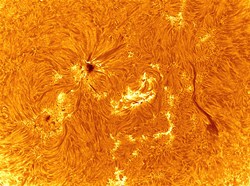 Active Region—A localized, transient volume of the solar atmosphere in which plages, sunspots, filaments, flares, etc., may be observed. Active regions are the result of enhanced magnetic fields; they are bipolar and may be complex if the region contains two or more bipolar groups.
Active Region—A localized, transient volume of the solar atmosphere in which plages, sunspots, filaments, flares, etc., may be observed. Active regions are the result of enhanced magnetic fields; they are bipolar and may be complex if the region contains two or more bipolar groups.
(Solar images courtesy of Jack Newton)
Please note that artistic talent is not required to complete the program. Just diagram what you see as well as your ability allows. Use a number 2A lead pencil for best results. Work as quickly as you can since changes can occur within minutes. On the “whole disk recording form” mark sunspots as small or large round black dots. Filaments should be drawn using short or long, narrow or wide black lines shaped as they appear to the eye. Plages and flares may be drawn with closed lines without shading. Limb prominences may be drawn with a shaded black outline. See sample drawings for examples. The focus of your drawings should be on the position, shape, and size of the features. Remember to label each feature in your drawings/images.
The Observing Program should be achievable with modest Ha equipment, such as the Coronado Personal Telescope (PST) and the like. Double stacking of filters is desirable to bring out greater detail in the surface of the Chromosphere.
Seeing conditions for Ha observing can be carried out by looking at the sharpness of the chromospheric network, spicules (chromospheric edge) and filaments using the following scale:
5—Near-perfect image. The details in the chromospheric network are well visible over the entire solar disk. There are no vibrations at the solar edge. Even the finest spicules are visible at the solar edge. The fine structure in filaments is well observable.
4—Very small details in the filaments and chromospheric faculae are visible over the entire solar disk. The chromospheric network is well visible. The solar limb is moving slightly.
3—A Chromospheric network is visible over the entire solar disk. Spicules, just like the smaller filaments are visible. The shape of the chromospheric faculae is well visible. The solar limb is vibrating a bit, but this vibration is hardly noticeable in the umbrae.
2—Only the big filaments are observable. There are hints of the chromospheric network. The chromospheric faculae melt into the chromospheric background. The solar limb is moving strongly and this movement is also visible in the umbrae of the sunspots.
1—Only the biggest and darkest filaments can be observed. Umbrae of the sunspots are not or hardly visible. The entire image is wavering.
Transparency also should be evaluated using the following scale:
1—The celestial background is very dark, and prominences are very distinct.
2—The celestial background is dark, and the prominences are distinct.
3—The celestial background is slightly bright, but the prominences are still distinct.
4—The celestial background is bright, and the prominences can only be seen with difficulty.

1 2 3 4
The observer must provide a log for each observation on the drawing sheets with information that includes:
- Location of observer’s site, including Latitude and Longitude
- Date and time of observation (either UT or local time).
- Seeing and Transparency using the rating scale for Hα viewing.
- The Telescope used including aperture and focal length.
- Eyepiece and magnification.
- Filter used and whether double stacked or not.
- Rotation number (can be obtained online or in astronomical almanacs).
The record of observation for imaging is the same as for visual certification, except specifics of how the image was obtained should be provided. This includes:
- camera type
- exposure times
- imaging software
- number of stacked images
Before setting up your equipment, you may want to see how the sun looks in hydrogen alpha light by checking out the GONG Network at http://gong.nso.edu where a global system of telescopes keeps constant vigil on the Sun with images and movie loops that are updated every minute.
Submitting for Certification
| Observers should submit their drawings and images along with the completed submission form to their society’s award coordinator or other member who is qualified and experienced in Ha viewing. This person shall examine the sketches or images and report completion of the program to the League’s Hydrogen Alpha Solar Observing Program Coordinator either by mail or email using the submission form.
Members-at-Large or members of societies that do not have awards coordinators should submit logs and drawings/images along with the submission form directly to the Hydrogen Alpha Solar Observing Program Coordinator. It is recommended that only copies of your log and drawings/images be sent; since the originals can be lost in the mail. We will not return originals unless the observer provides for postage. |
 |
Be sure to include your name, mailing address, email address, phone number, affiliated society, and to whom the certification should be sent.
Images in electronic format may be forwarded by any convenient means that accomplishes transfer or makes the images available for review. This may include mailing of a storage device such as a CD or flash drive, or posting the images on the internet. Please avoid sending prints or slides unless you do not want them back.
A certificate and pin will be mailed to the address provided, either to the observer or to a society officer for presentation.
Enjoy daytime observing!
Notes:
Recommended Reading:
- Jenkins, J.L., The Sun and How to Observe It, Springer-Verlag, NY 2009
- Jenkins, J.L., Guidelines for the Observation of Monochromatic Solar Phenomena, A Handbook of the Association of Lunar & Planetary Observers (A.L.P.O.), Solar Section, January 2010 (Downloadable from A.L.P.O. Website http://www.alpo-astronomy.org/)
- Handy, R., et al, Astronomical Sketching, A Step-by-Step Introduction, Springer-Verlag, NY 2007
- Pugh, P., Observing the Sun with Coronado Telescopes, Springer-Verlag, NY 2007
- MacDonald, L., How to Observe the Sun Safely, Springer-Verlag, NY 2003
Links:
- How to Safely Observe the Sun
- Solar Disk Drawing Form: download as PDF
- Sample Solar Disk Drawing Form: download as PDF
- Solar Prominence Drawing Form: download as PDF
- Sample Solar Prominence Drawing Form: download as PDF
- Whole Solar Disk Drawing Form: download as PDF
- Sample Whole Solar Disk Drawing Form: download as PDF
- Glossary of Major Hydrogen Alpha Terms: click here
- Submission Form: download as PDF
- Find your Observing Program Award
| Hydrogen Alpha Solar Observing Program Coordinator:
Mark Simonson
1519 Ridge Drive,
Camano Island, WA 98282
(360) 387-9548
Upon verification of your submission and of your active membership in the Astronomical League, your recognition (certificate, pin, etc.) will be sent to you or to the awards coordinator for your society, as you specified. Your name will also appear in an upcoming issue of the Reflector magazine and in the Astronomical League’s online database. Congratulations. Good luck with your next observing challenge. |



